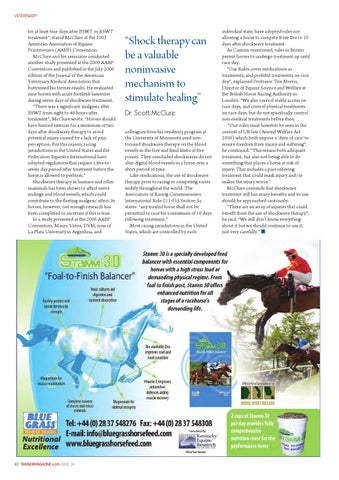SHOCKWAVE EURO.qxd:Jerkins feature.qxd
22/5/09
11:33
Page 3
VETERINARY
for at least four days after ESWT or RSWT treatment”, stated McClure at the 2003 American Association of Equine Practitioners (AAEP) Convention. McClure and his associates conducted another study presented at the 2006 AAEP Convention and published in the July 2006 edition of the Journal of the American Veterinary Medical Association that buttressed his former results. He evaluated nine horses with acute forelimb lameness during seven days of shockwave treatment. “There was a significant analgesia after ESWT from eight to 48 hours after treatment”, McClure wrote. “Horses should have limited exercise for a minimum of two days after shockwave therapy to avoid potential injury caused by a lack of pain perception. For this reason, racing jurisdictions in the United States and the Federation Equestre International have adopted regulations that require a five-toseven day period after treatment before the horse is allowed to perform.” Shockwave therapy in humans and other mammals has been shown to affect nerve endings and blood vessels, which could contribute to the fleeting analgesic affect. In horses, however, not enough research has been completed to ascertain if this is true. In a study presented at the 2006 AAEP Convention, Mauro Verna, DVM, now of La Plata University in Argentina, and
40 TRAINERMAGAZINE.com ISSUE 26
“Shock therapy can be a valuable noninvasive mechanism to stimulate healing” Dr. Scott McClure colleagues from his residency program at the University of Minnesota used nonfocused shockwave therapy on the blood vessels in the fore and hind limbs of five ponies. They concluded shockwaves do not alter digital blood vessels in a horse over a short period of time. Like medications, the use of shockwave therapy prior to racing or competing varies widely throughout the world. The Association of Racing Commissioners International Rule 011-015 Section 5a states: “any treated horse shall not be permitted to race for a minimum of 10 days following treatment.” Most racing jurisdictions in the United States, which are controlled by each
individual state, have adopted rules not allowing a horse to compete from five to 10 days after shockwave treatment. As Cumani mentioned, rules in Britain permit horses to undergo treatment up until race day. “Our Rules cover medications as treatments, and prohibit treatments on race day”, explained Professor Tim Morris, Director of Equine Science and Welfare at the British Horse Racing Authority in London. “We also control stable access on race days, and control physical treatments on race days, but do not specifically control non-medical treatments before then. “Our rules must however be seen in the context of UK law (Animal Welfare Act 2006) which both impose a ‘duty of care’ to ensure freedom from injury and suffering”, he continued. “This means both adequate treatment, but also not being able to do something that places a horse at risk of injury. That includes a pain relieving treatment that could mask injury and/or makes the injury worse.” McClure contends that shockwave treatment still has many benefits and its use should be approached cautiously. “There are an array of injuries that could benefit from the use of shockwave therapy”, he said. “We still don’t know everything about it but we should continue to use it, just very carefully.” I
